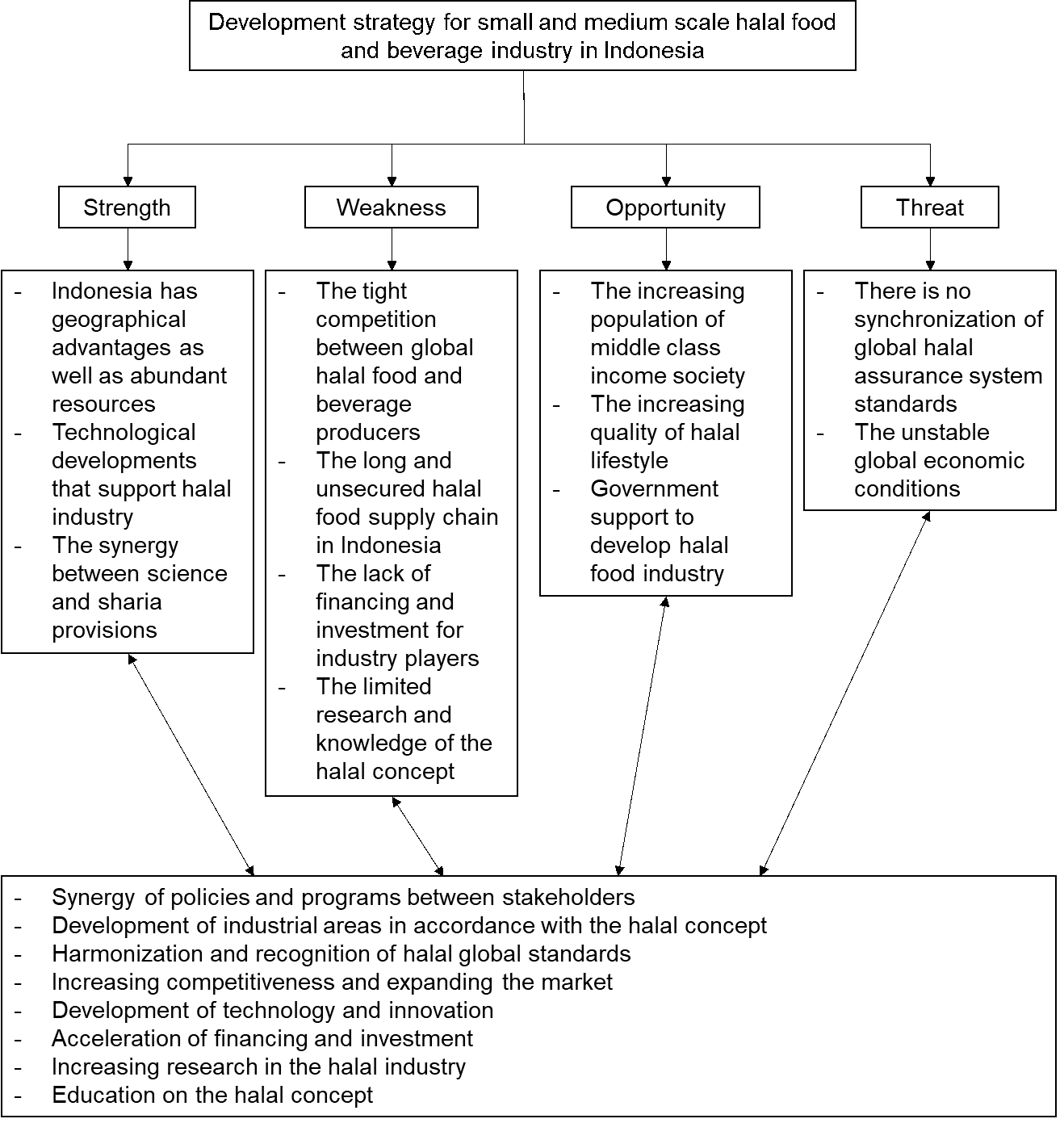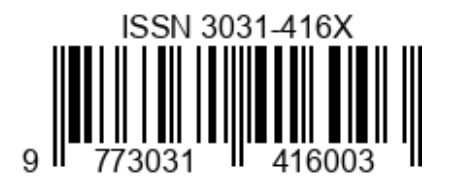Development strategy for small and medium-scale halal food and beveragesector in Indonesia
Abstract
Indonesia, with the world’s largest Muslim population, is the leading consumer of halal food and beverage.Despite its substantial consumer base, the country has not been able to capitalize on this demand to increasethe production of halal products. Therefore, this study aimed to identify strengths, weaknesses, opportunities,and threats (SWOT) facing halal food and beverage small and medium enterprises (SMEs) in Indonesia anddevelop growth strategies. The study procedures used Analytic Network Process (ANP) method combined withSWOT network structure to evaluate the factors affecting the sector. The results showed that the most significantstrength was the merger of food science with Islamic principles, while the primary weakness identified was theinsufficient financing and investment available to sector participants. Government backing had also become themost significant opportunity, while the most significant threat was the volatility of global economic conditions. Basedon these results, the strategic priority identified for advancing Indonesian halal food and beverage SEMs was overalldevelopment.
References
Ali MH, Tan KH, Ismail MD. A Supply Chain Integrity Framework for Halal Food. British Food Journal. 2017;119(1):20-31. https://doi.org/10.1108/BFJ-07-2016-0345
Ascarya, Yumanita D. Determinants and Persistence of Conventional and Sharia Banking Margins in Indonesia. Journal of Islamic Economics and Business. 2011;1(1):1-33.
Asmara AY, Rahayu S. Increasing the Competitiveness of Small and Medium Industries through Innovation and Utilization of Social Networks: Lessons from the Indian Software Industry Cluster. FEB UNSOED Research Journal. 2013;3(1).
[BI] Bank Indonesia Sharia Economic and Financial Development Policy. 2019.
[Bappenas] The Indonesia Masterplan of Sharia Economy 2019-2024. Jakarta: Deputy for Economics; 2018.
[BPS] Distribution of Quarterly GDP Series 2010 Based on Business Fields (Percent), 2014-2019. 2020.
Clapham R. Small and Medium Entrepreneurs in Southeast Asia. Jakarta: Institute for Economic and Social Research, Education and Information; 1991.
[Ditjen IKM] GEMA Small Industries. Jakarta: Directorate General of IKM, Ministry of Industry; 2018.
Gati W. SMEs Contribute to 60 Percent of Total Industrial Workforce Absorption. 2019.
Icha O. Effectiveness of Social Media Networks as a Strategic Tool for Organizational Marketing Management. J of Inter Bank and Comm. 2016;21(S2).
[IHLC] Indonesia Halal Economy and Strategy Roadmap. Jakarta: 2018.
Kusuma AAG, Pramudana KM. The Impact of Globalization on Markets and Production: Amidst the National Business Environment. Journal of Management, Business Strategy and Entrepreneurship. 2017;11(2):151-166.
Larasati BH. Analysis of the Relationship between Marketing Communications and the Quality of Competitiveness of Micro, Small and Medium Enterprises. [thesis]. Bogor: Bogor Agricultural Institute; 2011.
Lubis HN, Naim NFM, Alizul NN, Ahmed MU. From Market to Food Plate: Current Trusted Technology and Innovations in Halal Food Analysis. Trends in Food Science & Technology. 2016;58(1):55-68. https://doi.org/10.1016/j.tifs.2016.10.024
Lukitaningsih A. The Role of Segmentation in Consumer Behavior to Create Effective Advertising. Journal of Economics and Entrepreneurship. 2013;13(1):25-39.
Maison D, Marchlewska M, Zein RA, Syarifah D, Purba H. Religiously Permissible Consumption: The Influence of the Halal Label on Product Perceptions Depending on the Centrality of Religiosity. Journal of Islamic Marketing. 2019. https://doi.org/10.1108/JIMA-07-2018-0119
Mokhtar NF, Zuha RAH, M Abu SAH. Applying Technology Organization and Environment (TOE) Model in Social Media Marketing Adoption: The Case of Small and Medium Enterprise in Kelantan, Malaysia. The Social Sciences. 2016;11(21):5139-5144.
[MUI] Indonesia Halal Product Statistics Data 2012-2019. 2020.
Nasrullah A. Analysis of the Halal Industry Potential for Business Actors in Indonesia. 2017;pp. 50-78.
Nu'man AH. Small and Medium Industry Development Policy as an Effort to Face the Era of Free Trade. Journal. 2015;21(3):388-415.
[OJK] Sharia Banking Statistics - December 2019. 2020.
Purnomo D. Halal Agro-Industry Development Strategy in Anticipating Global Halal Business. [dissertation]. Bogor: Bogor Agricultural Institute; 2011.
Purwana ESD, Rahmi, Aditya S. Utilization of Digital Marketing for Micro, Small and Medium Enterprises in Malaka Sari Village, Duren Sawit. JPMM. 2017;1(1). https://doi.org/10.21009/JPMM.001.1.01
Randeree K. Demography, Demand, and Devotion: Driving the Islamic Economy. Journal of Islamic Marketing. 2019. https://doi.org/10.1108/JIMA-06-2018-0102
Risnawati N. Profile of MSEs, Problems and Empowerment Efforts in Sumedang Regency. Journal of Coopetition. 2018;9(1):13-29.
Samori Z, Ishak AH, Kassan NH. Understanding the Development of Halal Food Standard: Suggestions for Future Research. International Journal of Social Science and Humanity. 2014;4(1):482-485. https://doi.org/10.7763/IJSSH.2014.V4.403
Thomson Reuters. State of the Global Islamic Economic Report 2019/2020. New York: DinarStandard; 2019.
[UU] Number 33 of 2014 concerning Halal Product Guarantees.
Veer DK, Khiste GP, Deshmukh RK. Publication Productivity of 'Information Literacy' in Scopus during 2007 to 2016. Asian Journal Research Social, Science, Humanity. 2018;8:171-183. https://doi.org/10.5958/2249-7315.2018.00036.9
Waharini FM, Purwantini AH. Halal Food Industry Development Model in Indonesia. Muqtasid. 2018;9(1):1-13. https://doi.org/10.18326/muqtasid.v9i1.1-13
Zulfakar MH, Anuar MM, Talib SWA. Conceptual Framework on Halal Food Supply Chain Integrity Enhancement. Procedia - Social and Behavioral Sciences. 2012;pp. 58-67. https://doi.org/10.1016/j.sbspro.2014.01.1108

Copyright (c) 2024 Chodijah Puteri Rosadi, Tita Nursyamsiah

This work is licensed under a Creative Commons Attribution-ShareAlike 4.0 International License.











